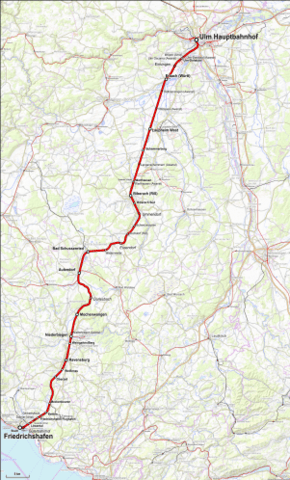Ulm–Friedrichshafen railway
The Ulm–Friedrichshafen railway, also known as the Württembergische Südbahn (Württemberg Southern Railway), is a non-electrified main line in the state of Baden-Württemberg, southern Germany. It was built from 1846 to 1850 and doubled from 1905 to 1913. During that time many of the station buildings were rebuilt. Its kilometre numbering begins as the Fils Valley Railway in Stuttgart Hbf.
| Ulm Hbf–Friedrichshafen railway | ||||||||||||||||||||||||||||||||||||||||||||||||||||||||||||||||||||||||||||||||||||||||||||||||||||||||||||||||||||||||||||||||||||||||||||||||||||||||||||||||||||||||||||||||||||||||||||||||||||||||||||||||||||||||||||||||||||||||||||||||||||||||||||||||||||||||||||||||||||||||||||||||||||||||||||||||||||||||||||||||||||||||||||||||||||||||||||||||||||||||||||||||||||||||||||||||||||||||||||||||||||||||||||||||||||||||||||
|---|---|---|---|---|---|---|---|---|---|---|---|---|---|---|---|---|---|---|---|---|---|---|---|---|---|---|---|---|---|---|---|---|---|---|---|---|---|---|---|---|---|---|---|---|---|---|---|---|---|---|---|---|---|---|---|---|---|---|---|---|---|---|---|---|---|---|---|---|---|---|---|---|---|---|---|---|---|---|---|---|---|---|---|---|---|---|---|---|---|---|---|---|---|---|---|---|---|---|---|---|---|---|---|---|---|---|---|---|---|---|---|---|---|---|---|---|---|---|---|---|---|---|---|---|---|---|---|---|---|---|---|---|---|---|---|---|---|---|---|---|---|---|---|---|---|---|---|---|---|---|---|---|---|---|---|---|---|---|---|---|---|---|---|---|---|---|---|---|---|---|---|---|---|---|---|---|---|---|---|---|---|---|---|---|---|---|---|---|---|---|---|---|---|---|---|---|---|---|---|---|---|---|---|---|---|---|---|---|---|---|---|---|---|---|---|---|---|---|---|---|---|---|---|---|---|---|---|---|---|---|---|---|---|---|---|---|---|---|---|---|---|---|---|---|---|---|---|---|---|---|---|---|---|---|---|---|---|---|---|---|---|---|---|---|---|---|---|---|---|---|---|---|---|---|---|---|---|---|---|---|---|---|---|---|---|---|---|---|---|---|---|---|---|---|---|---|---|---|---|---|---|---|---|---|---|---|---|---|---|---|---|---|---|---|---|---|---|---|---|---|---|---|---|---|---|---|---|---|---|---|---|---|---|---|---|---|---|---|---|---|---|---|---|---|---|---|---|---|---|---|---|---|---|---|---|---|---|---|---|---|---|---|---|---|---|---|---|---|---|---|---|---|---|---|---|---|---|---|---|---|---|---|---|---|---|---|---|---|---|---|---|---|---|---|---|---|---|---|---|---|---|---|---|---|---|---|---|---|---|---|---|---|---|---|---|---|---|---|---|---|---|---|---|---|---|---|---|---|
IRE-Sprinter near Ravensburg | ||||||||||||||||||||||||||||||||||||||||||||||||||||||||||||||||||||||||||||||||||||||||||||||||||||||||||||||||||||||||||||||||||||||||||||||||||||||||||||||||||||||||||||||||||||||||||||||||||||||||||||||||||||||||||||||||||||||||||||||||||||||||||||||||||||||||||||||||||||||||||||||||||||||||||||||||||||||||||||||||||||||||||||||||||||||||||||||||||||||||||||||||||||||||||||||||||||||||||||||||||||||||||||||||||||||||||||
| Overview | ||||||||||||||||||||||||||||||||||||||||||||||||||||||||||||||||||||||||||||||||||||||||||||||||||||||||||||||||||||||||||||||||||||||||||||||||||||||||||||||||||||||||||||||||||||||||||||||||||||||||||||||||||||||||||||||||||||||||||||||||||||||||||||||||||||||||||||||||||||||||||||||||||||||||||||||||||||||||||||||||||||||||||||||||||||||||||||||||||||||||||||||||||||||||||||||||||||||||||||||||||||||||||||||||||||||||||||
| Native name | Württembergische Südbahn | |||||||||||||||||||||||||||||||||||||||||||||||||||||||||||||||||||||||||||||||||||||||||||||||||||||||||||||||||||||||||||||||||||||||||||||||||||||||||||||||||||||||||||||||||||||||||||||||||||||||||||||||||||||||||||||||||||||||||||||||||||||||||||||||||||||||||||||||||||||||||||||||||||||||||||||||||||||||||||||||||||||||||||||||||||||||||||||||||||||||||||||||||||||||||||||||||||||||||||||||||||||||||||||||||||||||||||
| Line number | 751 | |||||||||||||||||||||||||||||||||||||||||||||||||||||||||||||||||||||||||||||||||||||||||||||||||||||||||||||||||||||||||||||||||||||||||||||||||||||||||||||||||||||||||||||||||||||||||||||||||||||||||||||||||||||||||||||||||||||||||||||||||||||||||||||||||||||||||||||||||||||||||||||||||||||||||||||||||||||||||||||||||||||||||||||||||||||||||||||||||||||||||||||||||||||||||||||||||||||||||||||||||||||||||||||||||||||||||||
| Technical | ||||||||||||||||||||||||||||||||||||||||||||||||||||||||||||||||||||||||||||||||||||||||||||||||||||||||||||||||||||||||||||||||||||||||||||||||||||||||||||||||||||||||||||||||||||||||||||||||||||||||||||||||||||||||||||||||||||||||||||||||||||||||||||||||||||||||||||||||||||||||||||||||||||||||||||||||||||||||||||||||||||||||||||||||||||||||||||||||||||||||||||||||||||||||||||||||||||||||||||||||||||||||||||||||||||||||||||
| Line length | 103.6 km (64.4 mi) | |||||||||||||||||||||||||||||||||||||||||||||||||||||||||||||||||||||||||||||||||||||||||||||||||||||||||||||||||||||||||||||||||||||||||||||||||||||||||||||||||||||||||||||||||||||||||||||||||||||||||||||||||||||||||||||||||||||||||||||||||||||||||||||||||||||||||||||||||||||||||||||||||||||||||||||||||||||||||||||||||||||||||||||||||||||||||||||||||||||||||||||||||||||||||||||||||||||||||||||||||||||||||||||||||||||||||||
| Number of tracks | 2 | |||||||||||||||||||||||||||||||||||||||||||||||||||||||||||||||||||||||||||||||||||||||||||||||||||||||||||||||||||||||||||||||||||||||||||||||||||||||||||||||||||||||||||||||||||||||||||||||||||||||||||||||||||||||||||||||||||||||||||||||||||||||||||||||||||||||||||||||||||||||||||||||||||||||||||||||||||||||||||||||||||||||||||||||||||||||||||||||||||||||||||||||||||||||||||||||||||||||||||||||||||||||||||||||||||||||||||
| Track gauge | 1,435 mm (4 ft 8 1⁄2 in) standard gauge | |||||||||||||||||||||||||||||||||||||||||||||||||||||||||||||||||||||||||||||||||||||||||||||||||||||||||||||||||||||||||||||||||||||||||||||||||||||||||||||||||||||||||||||||||||||||||||||||||||||||||||||||||||||||||||||||||||||||||||||||||||||||||||||||||||||||||||||||||||||||||||||||||||||||||||||||||||||||||||||||||||||||||||||||||||||||||||||||||||||||||||||||||||||||||||||||||||||||||||||||||||||||||||||||||||||||||||
| Operating speed | 140 km/h (87 mph) (maximum) | |||||||||||||||||||||||||||||||||||||||||||||||||||||||||||||||||||||||||||||||||||||||||||||||||||||||||||||||||||||||||||||||||||||||||||||||||||||||||||||||||||||||||||||||||||||||||||||||||||||||||||||||||||||||||||||||||||||||||||||||||||||||||||||||||||||||||||||||||||||||||||||||||||||||||||||||||||||||||||||||||||||||||||||||||||||||||||||||||||||||||||||||||||||||||||||||||||||||||||||||||||||||||||||||||||||||||||
| Route number | 4500 | |||||||||||||||||||||||||||||||||||||||||||||||||||||||||||||||||||||||||||||||||||||||||||||||||||||||||||||||||||||||||||||||||||||||||||||||||||||||||||||||||||||||||||||||||||||||||||||||||||||||||||||||||||||||||||||||||||||||||||||||||||||||||||||||||||||||||||||||||||||||||||||||||||||||||||||||||||||||||||||||||||||||||||||||||||||||||||||||||||||||||||||||||||||||||||||||||||||||||||||||||||||||||||||||||||||||||||
| ||||||||||||||||||||||||||||||||||||||||||||||||||||||||||||||||||||||||||||||||||||||||||||||||||||||||||||||||||||||||||||||||||||||||||||||||||||||||||||||||||||||||||||||||||||||||||||||||||||||||||||||||||||||||||||||||||||||||||||||||||||||||||||||||||||||||||||||||||||||||||||||||||||||||||||||||||||||||||||||||||||||||||||||||||||||||||||||||||||||||||||||||||||||||||||||||||||||||||||||||||||||||||||||||||||||||||||
The Southern Railway begins in Ulm and runs via Biberach an der Riß, Aulendorf and Ravensburg to Friedrichshafen. Several trains continue on the single-tracked line of the Lake Constance Belt Railway to Lindau.
The line has been undergoing upgrading and electrification since the spring of 2018, which requires line closures and replacement bus services. The work should be completed in 2021.
History
Under the technical direction of the civil engineer Ludwig Friedrich Gaab, commissioners Ludwig August von Autenrieth and Georg von Buhler examined an economic link between Ulm and Friedrichshafen from 1836. As an alternative, a canal connection was considered using the Riss and Schussen, which compared to a two-track railway connection promised slightly higher construction costs but much cheaper operations. With the act entitled Über den Bau von Eisenbahnen (on the construction of railways) of 18 April 1843, the Kingdom of Württemberg finally decided to build several railway lines that could be considered as the Northern, Western, Eastern and Southern Railway and would cover the most urgent transport needs of the kingdom.
The Southern Railway was part of a continuous railway line from the navigable Neckar in Heilbronn via Stuttgart and Ulm to Friedrichshafen on Lake Constance. The examination of different route alternatives selected a direct connection from Ulm to Friedrichshafen.[2]
The first isolated section of the line opened on 8 November 1847 between Friedrichshafen and Ravensburg. On 26 May 1849 this was followed by the section to Biberach an der Riss and on 1 June 1850 by the remaining section to Ulm. Initially, with a locomotive transported by horse-drawn wagons and nine wagons, a freight train carrying passengers ran as an island operation. As a result, Friedrichshafen had its own workshop from the beginning, since there was no connection to the railway’s Eßlinger workshop.
With the closing the gap of the Ulm–Geislingen section of the Fils Valley Railway from Stuttgart on 29 June 1850, the Royal Württemberg State Railways (Königlich Württembergischen Staats-Eisenbahnen or K.W.St.E.) won the race to Lake Constance, three years before the Royal Bavarian State Railways and thirteen years before the Grand Duchy of Baden State Railway.
Between 1905 and 1913 the Ulm–Friedrichshafen line was duplicated for military reasons.
1945–2011
After the Second World War, several stations that were located far away from the villages were closed down over the years. Similarly, with the exception of the Aulendorf–Herbertingen and Aulendorf–Kißlegg lines, all the branches with passenger services off the Southern Railway were closed.
Beginning in the 1990s, InterRegio trains operated between Saarbrücken and Lindau on the line. Since 1 July 1993, class NE81 diesel railbuses have been operated on the line popularly known as the Geißbockbahn (billy goat railway; this description comes from the song Auf de Schwäb’sche Eisenbahne, published in 1853) between Friedrichshafen and Ravensburg by the Bodensee-Oberschwaben-Bahn (Lake Constance–Upper Swabia Railway, BOB), founded on 15 October 1991, with services extended on 1 July 1997 to Aulendorf. As early as 1994, high demand led BOB to procure additional vehicles, including wagons borrowed from Hohenzollerischen Landesbahn (Hohenzollern State Railway, HzL). Some of the disused railway stations on the "billy goat railway" have now been reactivated. Stadler Regio-Shuttle RS1 diesel railcars have operated on the Southern Railway since autumn 1998 to cater for the increased traffic.
DB ZugBus Regionalverkehr Alb-Bodensee (DB RAB) has taken over the operation of local passenger services on the northern section of the Southern Railway. In 1999, the Laupheim West–Laupheim Stadt branch line, the last remaining section of the Laupheim West–Schwendi line, was reactivated, with services connecting to Langenau.
Since 2001
In 2001, InterRegio services were abandoned except for a pair of trains cut back to operate between Karlsruhe and Ulm. With the abolition of this type of train in late 2002, the remaining InterRegio train pair was replaced by an InterCity service on the Münster/Dortmund–Lindau–Innsbruck route.
As a replacement for the Interregio services, the Interregio-Express (IRE) train class was introduced on 15 December 2002.[3]
In July 2008, Biberach district and Deutsche Bahn decided to build an about 400 metre-long connecting curve from the Southern Railway to the existing line from Laupheim West to Laupheim Stadt (town) station. This would let direct services run from Biberach via Laupheim Stadt to Ulm. Construction work on this started in June 2009 and was completed in 2011.[4][5] As part of this upgrade, the entire signal system in Laupheim West station was modernised.[6]
The Regionalverband Donau-Iller (Danube-Iller Regional Association) has proposed the upgrade of the Ulm – Biberach – Aulendorf section as part of the Regio-S-Bahn Donau-Iller (Danube-Iller Regional S-Bahn). This would require the electrification of the line.
In addition, the construction of a new connection to the Ulm–Sigmaringen railway from Erbach to Ehingen was investigated in the course of planning for the Regio-S-Bahn Donau-Iller but was discarded.[7]
To compensate for the impact on the timetable of building Merklingen (Schwäbische Alb) station on the Wendlingen–Ulm high-speed railway, €3 million have been earmarked for upgrades on the Southern Railway.[8] Due to the additional stop, the travel time for regional trains between Stuttgart, Ulm and Friedrichshafen would be extended by two minutes.
Operations
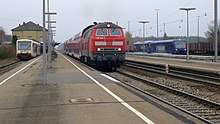
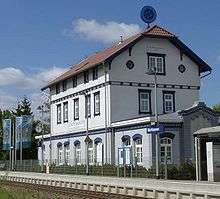
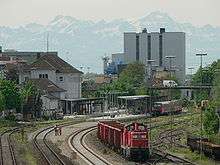
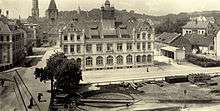
Class 611 diesel multiple units (which are to be replaced by class 612 sets[9]) run as InterRegio-Express services every two hours from Ulm via Friedrichshafen to Erzingen. Push–pull trains composed of locomotives of classes 218 or 245 and double-deck carriages are operated as a Regional-Express (RE) service every hour from Stuttgart via Ulm to Lindau (running as an IRE service between Stuttgart and Ulm), with the exception of one path, which is occupied by an IC train pair running between Münster and Bludenz. Regionalbahn (RB) services run hourly between Ulm and Biberach Süd and between Aulendorf and Friedrichshafen and Friedrichshafen Hafen. Between the peaks, Bad Schussenried is only served by the hourly RE service. The RB services are operated with class 650 (Regio Shuttle) diesel railcars belonging to DB Regio Alb-Bodensee (RAB), Bodensee-Oberschwaben-Bahn (BOB) and HzL. The single InterCity pair of trains is also hauled by a class 218 locomotive.
On Sundays and holidays trains run between (Stuttgart) Ulm, Friedrichshafen and Lindau at two-hour intervals, partly as special bicycle trains. They mainly consist of three to four Silberling cars or double-decker cars with a bicycle or baggage car and a class 218 diesel locomotive. In summer, on some weekends, a bicycle train (only 2nd class) runs from Ulm Hbf to Friedrichshafen Stadt as the RadExpress Bodensee. Bicycles can be taken for free on this train.
The regional services ran on the line on the basis of an underlying transport contract between the state and DB Regio, which ended in 2016. Bids for a successor contract were called at the end December 2014[10] and it was awarded to DB Regio again in March 2016. Although the contract, which runs until 2023, entered into force in December 2016, it was only signed on 16 January 2017. The part of the contract covering the so-called Netz 2, the Stuttgart–Ulm–Friedrichshafen–Lindau route, accounts for 2.6 million train-kilometers per year, of which about 94,000 train-kilometers per year are located in Bavaria. The Geislingen (Steige)–Ulm–Lindau RE service now operates every hour. Renovated double-decker cars with air conditioning, new seats, sockets on the square and Wi-Fi are used.[11][12] In the winter 2017/2018, DB Regio came under criticism for crowded trains and delays.[13]
Transport associations
From Ulm to Aulendorf the line is within the Donau–Iller Local Transport Network (Donau-Iller-Nahverkehrsverbund, DING ). From Aulendorf to Friedrichshafen it is within the Lake Constance–Upper Swabia Transport Association (Bodensee-Oberschwaben Verkehrsverbund, BODO).
Upgrading and electrification
Today, the Württemberg Southern Railway is one of the few non-electrified double-track mainline railways in southern Germany. Electrification including the continuation to Lindau has been agreed.[14] An upgrade to tap the potential for freight and possibly attract more long-distance trains to the line, which is currently (2018) only used by one Intercity train pair. The Federal Transport Infrastructure Plan (Bundesverkehrswegeplan) 2030 specifies a benefit/cost ratio of 2.7 for this measure.[15] It is listed as an urgent need.[16]
Planning and financing history
According to the Standardisierte Bewertung (standardised assessment), a cost-benefit ratio of between 1.8 and 2.4 depending on the option was first calculated mainly as a result of travel time savings and reduced air pollution. The project costs were estimated early on as well over €100 million.
The state of Baden-Württemberg and Deutsche Bahn concluded a planning agreement on 30 June 2009. The results of the planning would be available at the end of 2012.[17] Following a 2008 policy decision, the pre-planning cost of €1.24 million was financed by the Interessenverband Südbahn (Southern Railway Association), bringing together 24 cities and towns along the line.[18][19][20] In December 2010, Deutsche Bahn commissioned the project's environmental planning, which was to be completed between the end of 2010 and the end of 2013.[21]
The planning approval documents for the first of five sections were submitted to the Federal Railway Authority (Eisenbahn-Bundesamt) on 18 August 2011. The documents were due to be submitted for all five sections by the spring of 2012. In autumn 2011, construction was expected to start in 2013. The line speed would be increased to 160 km/h in sections.[18] The estimated cost of the construction of the electrification infrastructure over a total of 253 track-kilometres in September 2011 amounted to around €140 million. The government of Baden-Württemberg provided funding of €8 million for the design and planning approval process. In addition, Baden-Württemberg was willing to fund half of the construction costs.[18] Commissioning was scheduled for 2015.
The cost was estimated at €140 million in the spring of 2012. As a precaution, a cost of €180 million was assumed.[22] The federal and state governments agreed to share the financing of the estimated cost of €180 million.[23] Baden-Württemberg provided its share of financing of €90 million in 2013/14.[22] In autumn 2012, the cost estimate was raised from €180 to 226 million. The increase was due to the identification of water-logged ground, the need to upgrade cable ducts and the need for additional retaining walls. The increase in construction costs was accompanied by an increase in planning costs of €8.28 million, which became known in March 2013. The estimated cost of the overall project now amounted to €234.3 million.[23] It was planned to complete the electrification by the end of 2017.[24]
The financing of the additional costs has not been clarified. A financing agreement had not been reached in April 2013.[22] At the end of May 2013, the documents for the planning approval procedure were submitted for the last two of the five sections.[25] In mid-2014, Deutsche Bahn expected that all permits for all sections would be issued by the end of March 2015.[26] Another delay became known in the same month. According to the Federal Ministry of Transport, the financing agreement would now be signed at the earliest in 2014. The need for additional geophysical investigations was mentioned as a reason for the delay.[25]
According to the Federal Government in December 2013, the project would be completed in 2018.[27] Negotiations on the conclusion of a financing agreement were carried out between the federal and state governments in early 2014. The state pushed for an agreement to be signed in 2014. At the beginning of February 2014, the Baden-Württemberg Ministry of Transport internally anticipated costs to increase to €206 million. The release of the planning documents for the two outstanding sections was planned for April and May 2014 (as of February 2014).[28] The Federal Ministry of Transport announced mid-2014 that the "budgetary requirements for the start of construction on the Southern Railway currently do not exist". Incidentally, the project would become part of the newly modified Federal Transport Infrastructure Plan 2030.[29]
At the end of 2014, Deutsche Bahn was expecting the planning approval decision in the spring of 2015, with the financing agreement signed in the late summer of 2015 and the start of construction in 2016. Three years of construction were planned.[30] In November 2014, the state and the federal government agreed to complete the negotiations over the financing of the project in spring 2015 in Berlin.[31] Baden-Württemberg stated in April 2015 that it would like preparatory work to start in 2015. The state was expecting the planning approval decisions within two to three months.[32]
The Federal Ministry of Transport announced in January 2015 that no financing agreement could be concluded in 2015 due to a lack of funds.[33] The government of Baden-Württemberg assumed in April 2015 that the planning approval decisions would have been made by the middle of 2015. The federal government refused to negotiate a financing agreement prior to the issue of the construction permit, which would be issued with the planning approval.[34] Funding was provided in the state budget. The federal budget, however, provided no specific funding.[35] The economic evaluation for the Federal Transport Infrastructure Plan 2015, was nearing completion at the end of September 2015, showing a positive result. The state of Baden-Württemberg agreed in November 2015 to provide up to €112.5 million for the electrification of the line.[36] In early December 2015, the federal government released funds from the 2015 budget for the electrification of the Southern Railway.[37]
In 2016, the first ground-breaking ceremony for the upgrade was held in spring 2017 at the site of the new substation to be built in Niederbiegen.[38]
Planning status and financing
The financing agreement between Baden-Württemberg and Deutsche Bahn was signed shortly before Christmas 2015. The state agreed to take over half of the eligible costs – up to €112.5 million of €225 million. The electrification would be completed by the end of 2021.[39] A corresponding agreement would be concluded between the state and the federal government.[40]
It was agreed that after electrification of the line, an hourly Oberschwaben-Express would run between Stuttgart and Lindau, along with an hourly express between Ulm and Friedrichshafen. Regio-S-Bahn services would run every half hour between Ulm and Biberachshould.[19]
The project is divided into five planning approval sections (Planfeststellungsabschnitte, PFA), following district boundaries. It ends in Lindau at the junction with the line from Munich, which is also being electrified.[41] In November 2016 all planning decisions were completed.[42] The sections and planning stands are in detail:
- In PFA 1 (Ulm and Alb-Donau-Kreis), the hearing report was handed over to the Federal Railway Authority in March 2014.[34] The application for planning approval was requested on 18 August 2011. The consultation process was initiated on 14 December 2011 and the plans were publicly exhibited in January and February 2012. The planning approval decision was issued on 27 May 2015.[43]
- In PFA 2 (Biberach district), the planning documents were made publicly available in October/November 2012. In 2013, Deutsche Bahn submitted a new noise analysis, which was to be discussed at a separate meeting on 29 April 2014.[44] The hearing report was handed over to the Federal Railway Authority in August 2014.[34] The planning approval decision was issued on 15 October 2015[45]
- In PFA 3 (Ravensburg district), the planning documents were made publicly available from 24 February 2014.[44] The report of the hearing held by the Tübingen regional council was sent to the Federal Railway Authority on 30 December 2014.[34] The planning approval decision was issued on 15 October 2015[46]
- The PFA 4 (Bodenseekreis) extends in the north to the Ravensburg/Bodenseekreis district boundary and runs through Friedrichshafen station to the crossing of the Schlossstraße in Friedrichshafen. In addition, the proceedings cover the Lake Constance Belt Railway from Friedrichshafen to the border between Baden-Württemberg and Bavaria and the branch line to Friedrichshafen Port. The consultation process was completed in December 2014. The report of the hearing was sent to the Federal Railway Authority on 9 December 2014.[47] The planning approval decision was issued on 29 October 2015[48]
- The hearing into PFA 5 (Friedrichshafen–Lindau-Aeschach) took place on 16 December 2014. In 2015, the hearing was held by the administrative region of Swabia.[34] The planning approval decision is the subject of a complaint by a landowner.[49]
The laying of a second track between Friedrichshafen and Lindau was planned around 2006 but was later abandoned.[50]
In the summer of 2016, the construction of sections one and two was planned to be carried out in 2018.[51]
Construction
The groundbreaking ceremony for the electrification took place on 23 March 2018. It took place at Niederbiegen, where an electrical substation is being built. The track between Ulm and Laupheim West was closed from 10 September to 8 December 2018 for the construction of the foundations of the catenary pylons. The commissioning of the entire electrification from Ulm to Lake Constance is planned for autumn 2021.[52][53]
The planned track closures are shown in the table below:[52][54]
| Start | End | Section |
|---|---|---|
| 10 September 2018 | 8 December 2018 | Ulm–Laupheim West |
| 11 March 2019 | 15 July 2019 | Laupheim West–Biberach (one track only)
Biberach–Aulendorf |
| 16 September 2019 | 3 November 2019 | Ulm–Laupheim West |
| 4 November 2019 | 14 December 2019 | Biberach–Aulendorf |
| 2 March 2020 | 12 July 2020 | Aulendorf–Ravensburg |
| 24 September 2020 | 17 December 2020 | Ravensburg–Friedrichshafen |
| 22 February 2021 | 4 April 2021 | Aulendorf–Ravensburg |
| 5 April 2021 | 11 Juli 2021 | Ravensburg–Friedrichshafen |
Operations
After completion of the project, the line will be operable on certain sections at 160 km/h instead of 140 km/h. Depending on stops made, travel time between Ulm and Friedrichshafen is to be reduced from 72 minutes in 2017 to 62 minutes. Freight traffic is expected to more than double between 2016 and 2030.[55]
See also
References
Footnotes
- Eisenbahnatlas Deutschland (German railway atlas) (10 ed.). Schweers + Wall. 2017. pp. 104−5, 112, 163. ISBN 978-3-89494-146-8.
- Scharf & Wollny 1993, p. 86.
- "Neues Konzept für die Südbahn". Eisenbahn-Revue International (in German). 2: 52. 2003. ISSN 1421-2811.
- "unknown". Bahn-Report (in German) (5): 76. 2008.
- "Feierliche Eröffnung der neuen Bahnlinie Laupheim Stadt–(Südkurve)–Biberach (Riß) am 11. Juni 2011" (Press release) (in German). DB Mobility Logistics AG. June 2011.
- "Construction of southern curve at Laupheim" (in German). VBR News-net. Retrieved 15 May 2018.
- "Regio-S-Bahn Donau-Iller Ergebnisse der Hauptstudie" (PDF; 2.4 MB)) (in German). SMA/Intraplan. 27 November 2012. Archived (PDF) from the original on 26 March 2018. Retrieved 15 May 2018.
- "Bahnhof Merklingen volkswirtschaftlich sinnvoll" (Press release) (in German). Ministerium für Verkehr. 27 July 2016. Archived from the original on 30 July 2016. Retrieved 15 May 2018.
- "Land vergibt Vertrag für Neigetechnik im Netz "Donau-Ostalb: bis 2026 an DB Regio" (Press release) (in German). Ministerium für Verkehr und Infrastruktur Baden-Württemberg. 4 March 2016. Archived from the original on 22 December 2017. Retrieved 15 May 2018.
- "Land schreibt Betrieb für weitere Zugstrecken aus". Stuttgarter Nachrichten (in German). 2 January 2015. p. 17.
- "Bahnstrecke Stuttgart – Lindau: DB Regio erhält Zuschlag" (Press release) (in German). Ministerium für Verkehr Baden-Württemberg. Archived from the original on 15 May 2018. Retrieved 15 May 2018.
- "Verkehrsverträge für das Netz Stuttgart-Ulm-Bodensee und Donau-Ostalb unter Dach und Fach" (Press release) (in German). Ministerium für Verkehr Baden-Württemberg. Archived from the original on 15 May 2018. Retrieved 15 May 2018.
- "Bahn soll Kunden in Südwürttemberg entschädigen". Schwäbische (in German). Retrieved 15 May 2018.
- "Südbahn: Ausbau und Elektrifizierung wird Ende 2012 möglich" (in German). 1 December 2009. Archived from the original on 10 February 2010. Retrieved 16 May 2018.
- "BMVI - Publikationen-Bundesverkehrswegeplan 2030 – Gesamtplan" (PDF) (in German). Bundesministerium für Verkehr und digitale Infrastruktur. Retrieved 16 May 2018.
- "Drittes Gesetz zur Anderung des Bundesscheinenwegeausbaugesetzes" (PDF). Federal Gazette (in German): 2. Retrieved 16 May 2018.
- "Antwort der Bundesregierung auf die Kleine Anfrage der Abgeordneten Agnes Malczak, Dr. Anton Hofreiter, Bettina Herlitzius,weiterer Abgeordneterund der Fraktion BÜNDNIS 90/DIE GRÜNEN – Drucksache 17/7096 –" (PDF; 83 kB). Parliamentary records (in German). Deutscher Bundestag (17/7115). 11 October 2011. Retrieved 16 May 2018.
- "Planungen zu Elektrifizierung und Ausbau der Südbahn im Zeitplan" (Press release) (in German). Deutsche Bahn AG. 28 September 2011. Archived from the original on 18 November 2015. Retrieved 16 May 2018.
- Steibadler, Thomas (22 October 2015). "Neue Hindernisse für die Südbahn". Südwest Presse (in German). p. 31. Retrieved 16 May 2018.
- Baßler, Rüdiger (24 November 2015). "Neue Hindernisse für die Südbahn". Stuttgarter Zeitung (in German) (264). p. 28. Retrieved 16 May 2018.
- "D-Stuttgart: Umweltplanung". Electronic Journal of the European Union (in German) (2010/S 173–264963). 7 September 2010. Archived from the original on 10 June 2015. Retrieved 16 May 2018.
- "Wer die Mehrkosten bezahlt, ist unklar". Schwäbische Zeitung (in German). 9 April 2013.
- "Elektrifizierung wird noch teurer". Schwäbische Zeitung (in German). 16 March 2013. p. 2.
- "DB: Neue Pläne für Lindau – erst 2020 elektrisch nach München?". Schweizer Eisenbahn-Revue (in German) (10): 502. 2012. ISSN 1022-7113.
- Böhmer, Willi (21 June 2013). "Verzögerung Südbahn: Verkehrsminister Hermann ist sauer". Südwest Presse (in German). p. 21. Archived from the original on 24 September 2015. Retrieved 16 May 2018.
- Ruf, Reiner (6 June 2013). "Bahn investiert kräftig im Südwesten". Stuttgarter Zeitung (in German). p. 7. Archived from the original on 30 August 2017. Retrieved 16 May 2018.
- "Unterrichtung durch die Bundesregierung Bericht über die Projektfortschritte beim Ausbau der grenzüberschreitenden Schienenverkehrsachse" (PDF) (in German) (Drucksache 18/357). Deutscher Bundestag. 22 January 2014: 2. Retrieved 16 May 2018. Cite journal requires
|journal=(help) - Beck, Herbert. "Bei der Südbahn wartet das Land auf Zusagen aus Berlin". Schwäbische Zeitung (in German) (6 February 2014) (Leutkirch ed.). p. 2. Archived from the original on 22 December 2015. Retrieved 16 May 2018.
- Wieselmann, Bettina; Steibadler, Thomas (5 August 2014). "Südbahn auf dem Abstellgleis". Neue Württembergische Zeitung (in German). p. 6. Archived from the original on 24 September 2015. Retrieved 16 May 2018.
- Kübler, Rudi; Mayer, Hans-Uli (16 December 2014). "Südbahn kommt noch vor S 21". Südwest Presse (in German). p. 15.
- Mohl, Annette (31 December 2014). "Südbahn Ulm–Lindau nimmt Fahrt auf". Stuttgarter Nachrichten (in German). p. 7. Archived from the original on 26 March 2017. Retrieved 16 May 2018.
- "Land macht Druck bei der Südbahn". Schwäbische Zeitung (in German). 22 April 2015. p. 2.
- "Manne Lucha: "Durchbruch bei der Südbahn"". Schwäbische Zeitung (in German). 26 January 2015. p. 22.
- "Mitteilung der Landesregierung Bericht der Landesregierung zu einem Beschluss des Landtags; hier: Ausbau der Südbahn" (PDF) (in German). 15 (6724). Landtag of Baden-Württemberg. 13 April 2015. Retrieved 16 May 2018. Cite journal requires
|journal=(help) - "Kretschmann gegen Dobrindt". Südwest Presse (in German). 22 April 2015. p. 1.
- "Hermann sagt 112,5 Millionen für Südbahn zu". Südwest Presse (in German). 17 November 2015. p. 25.
- "Verkehrsminister unterschreibt Südbahn-Vertrag". Südwest Presse (in German). 24 December 2015. p. 5. Archived from the original on 1 February 2016. Retrieved 16 May 2018.
- "Spatenstich für Elektrifizierung der Südbahn steht" (in German). schwaebische.de. 8 November 2016. Archived from the original on 1 September 2017. Retrieved 16 May 2018.
- "Land und Bahn schließen Vertrag". Stuttgarter Zeitung (in German) (298). 24 December 2015. p. 25.
- "Südbahnvertrag unterschrieben". Badische Zeitung (in German). 24 December 2015. p. 9. Archived from the original on 2 February 2016. Retrieved 16 May 2018.
- Löffelholz, Felix (8 February 2014). "Südbahn-Ausbau kommt nur zäh voran". Südkurier (in German). Archived from the original on 5 March 2016. Retrieved 16 May 2018.
- bauprojekte.deutschebahn.com. "Bauprojekt Ulm – Friedrichshafen – Lindau-Aeschach | BauInfoPortal der Deutschen Bahn" (in German). Deutsche Bahn AG, Unternehmensbereich Personenverkehr, Marketing eCommerce. Archived from the original on 15 August 2017. Retrieved 16 May 2018.
- "Planfeststellungsbeschluss gemäß § 18 AEG für das Vorhaben "Ulm, Elektrifizierung Südbahn Pfa 1 (...)"" (PDF) (in German). Karlsruhe: Eisenbahn-Bundesamt, Außenstelle Karlsruhe/Stuttgart. 27 May 2015. p. cover sheet, 34, 35. Archived from the original (PDF) on 4 March 2016. Retrieved 16 May 2018.
- "Elektrifizierung der Südbahn, Planfeststellungsabschnitt 2 im Landkreis Biberach: Auslegung der geänderten Gesamtlärmbetrachtung und Bekanntmachung des Erörterungstermins" (in German). Tübingen region.
- "Planfeststellungsbeschluss gemäß § 18 AEG für das Vorhaben Biberach, Elektrifizierung Südbahn PfA 2 (Ulm -Friedrichshafen - Lindau- Aeschach ) (...)" (PDF) (in German). Karlsruhe: Eisenbahn-Bundesamt, Außenstelle Karlsruhe/Stuttgart. 15 October 2015. pp. cover sheet, 34, 35. Archived from the original (PDF) on 6 November 2016. Retrieved 16 May 2018.
- "Planfeststellungsbeschluss gemäß § 18 AEG für das Vorhaben "Elektrifizierung der Eisenbahnstrecke Ulm - Friedrichshafen - Lindau- Aeschach (Südbahn)" im Planfeststellungsabschnitt 3, Landkreis Ravensburg (...)" (PDF) (in German). Eisenbahn-Bundesamt Außenstelle Hannover. 15 October 2015. Archived from the original (PDF) on 6 November 2016. Retrieved 17 May 2018.
- "Anhörungen zur Südbahn sind abgeschlossen". Schwäbische Zeitung (in German). 13 December 2014. p. 12.
- "Planfeststellungsbeschluss gemäß § 18 AEG für das Vorhaben "Ulm, Elektrifizierung Südbahn im Planfeststellungsabschnitt 4, Bodenseekreis (...)"" (PDF) (in German). Eisenbahn-Bundesamt, Außenstelle Hannover. 29 October 2015. Archived from the original (PDF) on 6 November 2016. Retrieved 17 May 2018.
- "Klage gegen Elektrifizierung der Südbahn". Schwäbische Zeitung (in German). 17 October 2016. p. 20. Archived from the original on 24 July 2017. Retrieved 17 May 2018.
- "Neuer Dampf für die Südbahn". Schwäbische Zeitung (in German). 30 June 2015. p. 24. Archived from the original on 30 August 2017. Retrieved 17 May 2018.
- "Friedrichshafen: Zeitplan für Südbahn bisher nicht gefährdet Online". Südkurier (in German). Archived from the original on 30 August 2017. Retrieved 17 May 2018.CS1 maint: BOT: original-url status unknown (link)
- "Elektrifizierung: Südbahn neun Wochen gesperrt". Südwest Presse (in German). 24 February 2018. Archived from the original on 17 May 2018. Retrieved 17 May 2018.
- "Friedrichshafen: Startschuss für Elektrifizierung der Südbahn: Historischer Moment für regionalen Schienenverkehr". Südkurier Medienhaus (in German). Archived from the original on 25 March 2018. Retrieved 17 May 2018.
- "Schienenersatzverkehr im Rahmen der Elektrifizierung der Südbahn" (PDF). Parliamentary records (in German). Landtag of Baden-Württemberg (16/2650). 18 September 2017. Retrieved 17 May 2018.
- "Antwort der Bundesregierung auf die Kleine Anfrage der Abgeordneten Matthias Gastel, Harald Ebner, Stephan Kühn (Dresden), weiterer Abgeordneter und der Fraktion BÜNDNIS 90/DIE GRÜNEN – Drucksache 18/12719 –" (PDF). Parliamentary records (in German). Berlin: Deutscher Bundestag. 18 (13070): 3 f. 6 July 2017. ISSN 0722-8333. Retrieved 17 May 2018.
Sources
- Scharf, Hans Wolfgang; Wollny, Burkhard (1993). Die Eisenbahn am Bodensee [The railway to Lake Constance] (in German). EK Freiburg. ISBN 3-88255-758-3.CS1 maint: ref=harv (link)
- Scherer, Thomas (1982). Eisenbahnen in Württemberg [Railways in Württemberg] (in German). II: Der Bahnknotenpunkt Aulendorf. Ulm: Spurkranz-Verlag.
- Schmidt, Uwe (2004). Die Südbahn. Eisenbahn und Industrialisierung in Ulm und Oberschwaben [The Southern Railway. Railways and industrialisation in Ulm and Upper Swabia] (in German). Ulm: Süddeutsche Verlags-Gesellschaft. ISBN 3-88294-342-4.
- Supper, Otto (1981). Die Entwicklung des Eisenbahnwesens im Königreich Württemberg [The development of railways in the Kingdom of Württemberg] (in German). Stuttgart: Kohlhammer. ISBN 3-17-005976-9. (reprint of 1895 edition)
External links
| Wikimedia Commons has media related to Southern Railway (Württemberg). |
